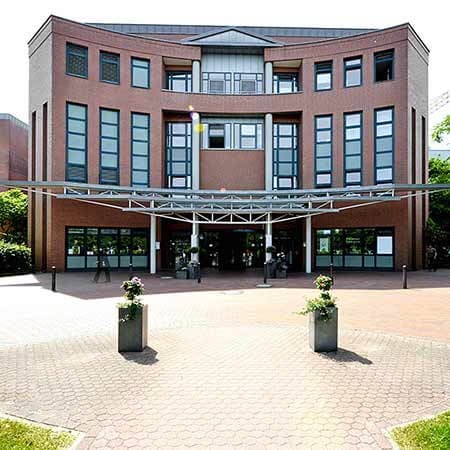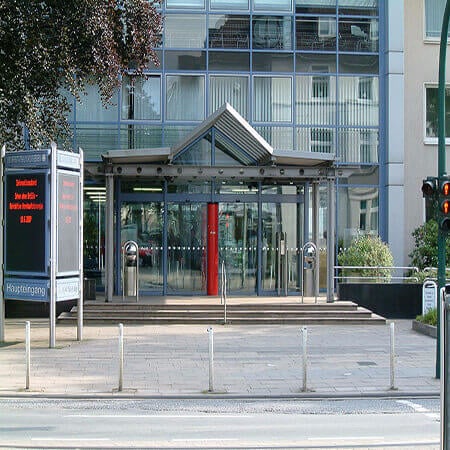Atrioventricular valve dysplasia is one of the common causes of regurgitation (reverse flow) of blood from the ventricles into the atria. In the natural course, pathology leads to heart failure. To prevent it, heart valve repair is required. Less commonly, doctors resort to heart valve replacement. Medical specialists in developed countries perform not only open, but also minimally invasive surgical interventions to repair both mitral and tricuspid valves. Such interventions are used in patients with high surgical risk.
Content
- What is atrioventricular valve dysplasia/a>
- Treatment principles
- Mitral valve surgery
- Minimally invasive mitral valve repair
- Tricuspid valve surgery
- Minimally invasive heart valve replacement surgery
- Treatment in Europe at an affordable price
What is atrioventricular valve dysplasia
Valve dysplasia is a congenital valve insufficiency, which usually develops due to a poor connective tissue condition. Such patients have problems not only with the heart valves, but they also often suffer from aneurysms (local enlargements) of large vessels, as well as joint and spinal pathologies.
The heart valves suffer from disorganization of the fibrous skeleton of the leaflets. This results in the development of valvular insufficiency.
There are two atrioventricular valves in the human heart:
- Mitral valve – in the left half of the heart, located between the left atrium and the left ventricle.
- Tricuspid valve – located between the atrium and ventricle in the right half of the heart.
Any of them, and sometimes both, can be involved in the pathological process. Dysplasia of the valves of the arterial (left) half of the heart develops more often. Less commonly, and usually later, the tricuspid valve becomes affected as well.
Dysplasia causes the development of valvular insufficiency (regurgitation). This is a condition in which some of the blood flows back into the atrium as the ventricles contract. The more blood returns, the more severe the regurgitation, the greater the load on the heart and the faster the pathological changes progress. Long-term valve dysplasia-related insufficiency leads to expansion (dilatation) of the heart chambers and heart failure. These changes are usually irreversible, so valve correction should be done before ventricular dilatation develops.
Valvular insufficiency does not develop immediately after birth. Although congenital connective tissue dysplasia is at the root of the disease, most patients develop symptoms only after 30 years. For some, they only manifest themselves in old age. The older the person, the higher the risk of severe regurgitation due to dysplasia.
Treatment principles
The treatment of AVD is only surgical. There are no medications or non-drug treatments that can improve the condition of the heart valves.
For the treatment of atrioventricular valve dysplasia, one of two approaches can be used:
- Repair, which is the preferred option.
- Heart valve replacement, which is used less often, since the results of such interventions are worse.
Mitral insufficiency is more common. It develops due to prolapse (reverse bending) of the valve leaflets, stretching or separation of the chords – the threads that hold the valves. Therefore, surgical interventions are more often performed on the mitral valve. With the timely detected defect and its successful correction, the likelihood of developing severe tricuspid valve regurgitation is reduced.
The standard treatment is open-heart surgery. The patients with high surgical risk can undergo minimally invasive heart valve repair. In addition, if a person has previously undergone heart valve replacement or annuloplasty (heart valve repair with the reinforcement of its opening with a support ring), repeated interventions on the heart can be performed using minimally invasive techniques.
Mitral valve surgery
More often, the treatment of AVD involves performing mitral valve surgery.
In countries with poorly developed medicine, mitral valve replacement surgery is still frequently performed. Nonetheless, it provides the worst results. The patients have worse left ventricular function, lower quality of life and life expectancy after such interventions. Therefore, doctors in Europe rarely perform such interventions. In developed countries, the share of heart valve replacement surgeries does not exceed 10%. In 90% of cases, valve repair surgery is performed.
Most surgical interventions are performed on an open heart. Doctors make a large incision in the center of the sternum and use a heart-lung machine. Although such operations are traumatic, they are the most reliable and provide the best immediate and long-term treatment outcomes. The open repair surgery reduces regurgitation to a minimum.
Below are some manipulations that a doctor can perform to restore the heart valve function:
- Suturing the valve leaflets to the annulus fibrosus.
- Reinforcing the annulus fibrosus with sutures or support rings (support rings are more often used, since they give more reliable long-term results and provide better function of the left ventricle of the heart).
- Repair of chords with autologous or artificial materials.
Mitral valve repair surgery is technically complex and not always successful. Such interventions are best performed in hospitals in developed countries. The unsuccessfully performed heart valve repair gives inferior results in comparison with a well performed valve replacement surgery.
Doctors in developed countries rarely perform heart valve replacement surgery. It becomes an option of choice only if the valve is badly damaged and cannot be repaired. Even if the heart valve replacement is performed, then, if possible, with the preservation of the chords. Such an approach ensures the best function of the heart after the operation.
Most patients with mitral valve dysplasia are relatively young patients. Therefore, preference is given to mechanical prostheses. They can serve for over 30 years, but such prostheses have disadvantages: hemodynamics are worse, and the risk of blood clots is increased. To avoid the development of blood clots, patients are forced to use anticoagulants for life. They are taken under the control of a coagulogram. The insufficient doses increase the risk of thromboembolic complications, while the excessive ones increase the likelihood of severe bleeding.
Less commonly, surgical interventions are performed on patients with a low life expectancy. They are implanted biological prostheses that last 10-15 years. After their implantation, anticoagulant therapy is required only for 3 months. These valves provide better hemodynamics. In the future, repeated replacement surgery may be required due to dysfunction of the valve prosthesis, but this intervention in Europe is often performed using a minimally invasive technique – through the blood vessels in the leg.
Minimally invasive mitral valve repair
Some patients are contraindicated for surgical treatment of atrioventricular valve dysplasia due to the presence of severe concomitant diseases. In such situations, mitral valve repair can be performed with minimally invasive techniques. These surgical interventions are performed through the vessels in the leg or through minimal incisions on the thorax, without a heart-lung machine. They have minimal mortality rates and a low risk of complications, but they also have a drawback: minimally invasive interventions are less effective.
Nevertheless, transcatheter manipulations provide good results. In 75% of patients, they reduce the degree of mitral regurgitation to a second or lower. As a result, the quality of life improves, symptom relief occurs, exercise tolerance increases, and the progression of heart failure slows down.
Most transcatheter techniques are relatively advanced, so long-term results of their application are unknown. The first system to be used for mitral valve repair was the MitraClip system. It has been in use since 2003. This is a "clothespin" that tightens the heart leaflets and reduces the valve area. Good functional outcomes with this method of treatment are maintained in 90% of cases within 10 years of observation.
The technique has some limitations. It can be used when the mitral valve area is more than 4 square centimeters. With a smaller area, the procedure can lead to mitral stenosis – a violation of blood flow due to excessive narrowing of the left atrioventricular opening.
Since 2013, European hospitals have been using the NeoChord system for minimally invasive chord prosthetic repair. It is the technique of choice for patients with prolapse and degenerative origin of valvular insufficiency. It is often used for mitral dysplasia. Artificial chords are placed using the minimally invasive access, but the surgical intervention is performed not through the vessels in the leg, but through small incisions in the thorax.
In the twenty-first century, many other methods of minimally invasive treatment methods have been developed. These newly developed minimally invasive procedures allow reinforcing the annulus fibrosus of the heart valve, tightening the leaflets or repairing the chords. Most of the methods are not yet standard procedures for the treatment of AVD, but they are already being used in developed countries in patients for whom open-heart surgery is contraindicated.
Tricuspid valve surgery
Although tricuspid valve dysplasia develops in many patients suffering from congenital connective tissue defects, surgery is less frequently performed for its insufficiency. Only severe regurgitation or enlargement of the right ventricle requires correction. The patients with mild to moderate insufficiency usually do not suffer from symptoms.
Tricuspid regurgitation is usually relative: it is associated with the dilatation of the annulus fibrosus. However, the peculiarity of the defect with dysplasia is that the regurgitation is caused by a dysfunction of the valve itself, but not by the expansion of the atrioventricular orifice.
Tricuspid regurgitation develops independently of mitral insufficiency, but mitral disease can increase its severity by expanding the chambers of the heart and increasing the diameter of the atrioventricular orifice.
The main surgical intervention on a tricuspid valve is its repair. Doctors enlarge the anterior leaflet or repair the valve by placing artificial chords made of polytetrafluoroethylene. Less commonly, the annulus fibrosus strengthening (annuloplasty) is required. If there are contraindications to open surgery, the repair is performed using minimally invasive techniques.
Tricuspid valve replacement surgery is very rare. If it is required, then even in young patients, predominantly biological prostheses are implanted in the tricuspid position, since mechanical ones are associated with an increased risk of blood clot formation.
Minimally invasive heart valve replacement surgery
In Europe, the primary treatment of atrioventricular valve dysplasia usually does not involve the use of minimally invasive prosthetic techniques. Nonetheless, they are used when it is necessary to perform the second surgical intervention. The most widespread are two methods:
- Valve in the prosthesis – implantation of a new artificial valve inside the old bioprosthesis, in the event of its dysfunction.
- Valve in the annulus – implantation of an artificial valve inside the annulus after annuloplasty (annulus fibrosus repair).
The procedure is performed with access through the blood vessels in the leg. It reduces the number of open-heart surgeries for patients with valve dysplasia.
Treatment in Europe at an affordable price
To undergo treatment in one of the European hospitals, please use the services of the Booking Health company. On our website, you can find out the cost of treatment in Europe and compare prices in order to book a medical care program at a favorable price. The treatment in Europe will be easier and faster for you, and the cost of treatment will be lower.
You are welcome to leave your request on the Booking Health website. Our specialist will contact you and provide a free consultation on medical treatment in Europe. Booking Health will take care of the organization of your trip abroad. We will provide the following benefits for you:
- We will select a hospital for treatment in Europe, whose doctors specialize in the treatment of atrioventricular valve dysplasia and achieve the best results.
- We will solve the problem of the language barrier and help to establish communication with your attending physician.
- We will reduce the waiting time for the medical care program. You will undergo treatment on the most suitable dates.
- We will reduce the price. The cost of treatment in European hospitals will be lower due to the lack of overpricing and additional coefficients for foreign patients.
- We will help you solve any organizational issues: we will draw up documents, meet you abroad and take you to the hospital, book a hotel, and provide interpreting services.
- We will prepare a program and translate medical documents. You will not need to repeat the previously performed diagnostic procedures.
- We will help you keep in touch with the hospital after the completion of treatment in Europe.
- We will arrange additional diagnostic examinations and treatment in European hospitals, if required.
- We will buy medicines in another country and forward them to your native country.
The world's leading doctors will take care of your health. The specialists working at the Booking Health company will help reduce the cost of treatment, organize your trip, and you can fully focus on restoring your health.
Authors: Dr. Nadezhda Ivanisova, Dr. Sergey Pashchenko














